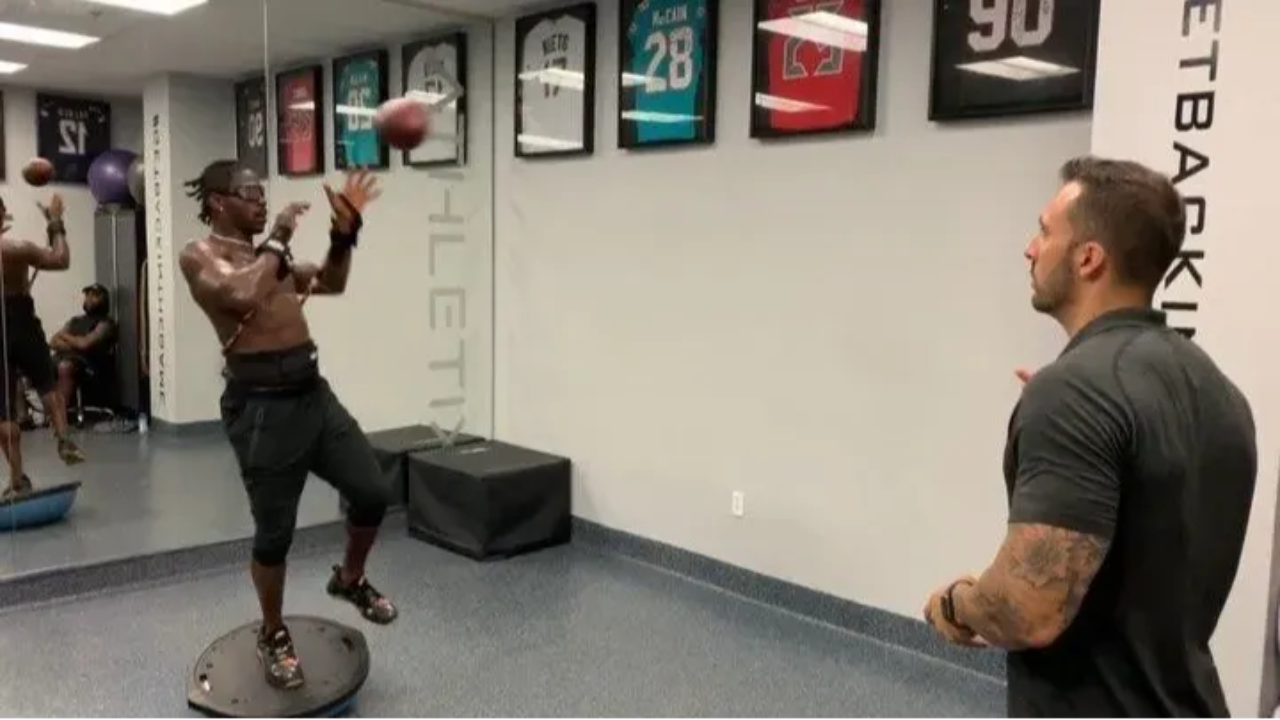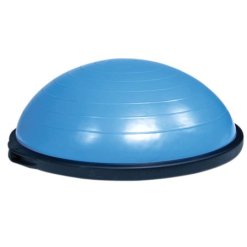Stable v's Unstable Training
Jul 21, 2019
This topic always causes debate, discussion and disagreement among physios and trainers due to some taking unstable surface training into the realms of stupidity. This was recently the case when American Football Player Antonio Brown of the Oakland Raiders was filmed during his 'offseason training' catching footballs whilst standing on one leg, on a bosu ball, wearing strobe glasses, whilst pretending to run. See the video here.
This caused a lot of discussion and controversy with many physios and trainers rolling their eyes and facepalming so hard you could hear the sound over the internet. Some even made parody videos here which are hilarious but upset others claiming its disrespectful... *insert eye roll here*
So what is the purpose of unstable surface training? Does it help produce faster, stronger, better athletes? Is it needed?
Unstable vs Stable Balance Training
Once we determine which athletes require lower extremity (LE) balance training we must then determine what kind of training to implement. The two types of balance training that we will discuss in this post are Unstable Surface Training (UST) and Stable Surface Training (SST). Many other experienced professionals have discussed this topic previously (see below) but due to recent trends in sports physical therapy, I believe it is an important topic to refresh.
- https://www.t-nation.com/training/bosu-ball-the-good-bad-and-ugly
- https://ericcressey.com/5-important-lessons-on-balance-training
- https://athlete.io/1771/unstable-surfaces-for-stability-training-aka-clown-school/
- https://tonygentilcore.com/2013/11/unstable-surface-training-fit/
Definitions
Definitions quoted by Kibele et al.
Balance: “a fundamental requirement for athletic performance and everyday activities. Balance can be considered as a (task-specific) ability of an individual to control either static or dynamic equilibrium while maintaining a stable position”
Stability: “the body’s resistance to being moved out of the present state of motion, linear or rotary, by external forces or torques.”
Stability is always changing based on what is going on around the athlete which affects an athlete’s ability to maintain balance.
Athletes who can benefit from UST
If you asked my opinion I would argue that UST is never truly needed and personally, I rarely use it. However, in order to be thorough, it is important to determine which athletes can actually benefit from this type of training.

Athletes with Previous Injury
One of the greatest risk factors for injury is previous injury. Athletes who have sustained previous lower extremity injury are individuals who may benefit from unstable surface training. Verhagen et al. published a study looking at balance board training for the prevention of ankle sprains. The results showed that athletes who previously had sprained there ankle responded to the UST but healthy athletes with no previous injury showed no benefit. Athletes with previous injury will also greatly benefit from stable surface training, but especially during early stages of lower extremity injury UST can provide a stimulus to improve balance and proprioception on the injured limb.
Athletes Rehabbing from Lower Extremity Injury
The second group of athletes who can benefit from UST are athletes rehabbing from significant ankle, knee or hip injury during early to mid-stage rehab. Training on unstable surfaces produces increased higher muscular activation including co-activation which increased the stiffness of a limb in order to protect it from excessive force output. These interventions are most useful in early-stage rehab when the athletes may not be able to tolerate significant load and force output due to weakness and muscular inhibition.
“Physical therapists should consider IRT (instability resistance training) as a progressive component in the rehabilitation training program that may begin with solely balance training (no load), progressing to balance challenges with resistance (IRT) to traditional ground based RT with greater loads and intensities.” (Behm et al)
Once we build the athletes capacity to tolerate progressive load, UST needs to be replaced immediately. Unstable surface training not only reduces force output but also reduces range of motion due to co-contraction which are two extremely important, yet commonly overlooked areas when it comes to sport rehab. In my opinion, training rehabbing athletes on unstable surfaces throughout their recovery will produce a significantly under loaded athlete who is unprepared to generate the force output needed to return to sport safely.
When can UST be counterproductive?
Trained Athletes
Prehab is also a very trendy topic in sports rehab and it involves the treatment of healthy athletes in order to reduce the chance of future injury. In this situation, we run the risk of negatively affecting our athletes training and performance if we decide to use UST.
Cressey, West, Tiberio et al. investigated the potential effects of a 10 week lower body unstable surface training on athletic performance in healthy athletes. The athletes were tested on jump, sprint and agility performance measures.
“The primary findings of this study were that 10 weeks of lower-body UST attenuated improvements in both short- and long-lasting SSC jumping performance and 40- yard sprint time when compared with a stable surface program identical in all other programming variables.” (Cressey, West, Tiberio et al.)
This shows that utilizing unstable surface training in healthy athletes can actually have a negative effect on performance. Stable surface training can provide a similar benefit to unstable surface training for balance and proprioception and lacks the potential negative effects of instability training. Athletes have a very short window to recover and prepare during their off-season and as sports medicine professionals we must be making appropriate decisions for our athletes to maximize their efficiency in preparation.
The authors of this study also offer insight into what program design should look like.
“Instead, program design with healthy athletes should adhere to the principle of specificity with respect to training surfaces just as it would for other characteristics of muscular actions” (Cressey, West, Tiberio et al.)
With that said, as physical therapists we must design our rehab programs to reflect this as well. A good rehab program should add on to the benefits of a training program and not take away from the effects of training in healthy athletes.
My charge to sports medicine professionals is this: Always be wary of trends on social media, think critically about the times and situations in which you chose to implement UST, and always be prepared to back your decisions with evidence.
Sources
Behm, David G., et al. “Effects of Strength Training Using Unstable Surfaces on Strength, Power and Balance Performance Across the Lifespan: A Systematic Review and Meta-Analysis.” Sports Medicine, vol. 45, no. 12, 2015, pp. 1645–1669., doi:10.1007/s40279-015-0384-x.
Cressey, Eric M., et al. “The Effects Of Ten Weeks Of Lower-Body Unstable Surface Training On Markers Of Athletic Performance.” Journal of Strength and Conditioning Research, vol. 21, no. 2, 2007, pp. 561–567., doi:10.1519/00124278-200705000-00047.
Kibele, Armin, et al. “Stable, Unstable and Metastable States of Equilibrium: Definitions and Applications to Human Movement.” Journal of Sports Science and Medicine, Dec. 2015.
Lehmann, Tim, et al. “Single-Leg Assessment of Postural Stability After Anterior Cruciate Ligament Injury: a Systematic Review and Meta-Analysis.” Sports Medicine – Open, vol. 3, no. 1, 2017, doi:10.1186/s40798-017-0100-5.
Mcbride, Jeffrey M., et al. “Isometric Squat Force Output and Muscle Activity in Stable and Unstable Conditions.” The Journal of Strength and Conditioning Research, vol. 20, no. 4, 2006, p. 915., doi:10.1519/r-19305.1.
Verhagen, Evert, et al. “The Effect of a Proprioceptive Balance Board Training Program for the Prevention of Ankle Sprains.” The American Journal of Sports Medicine, vol. 32, no. 6, 2004, pp. 1385–1393., doi:10.1177/0363546503262177.
Stay connected with new blogs and updates!
Join my mailing list to receive the latest blogs and updates.
Don't worry, your information will not be shared.
I hate SPAM, so I promise I will never sell your information to any third party trying to sell you laser guided acupuncture needles or some other BS.

